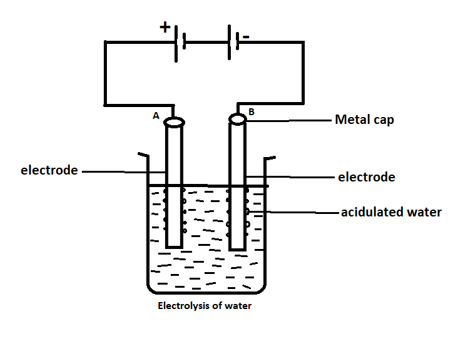
Look at the diagram which shows electrolysis of water and answer the following question. What is produced from a positive carbon electrode (anode)?

A. Oxygen
B. Carbon dioxide
C. Ozone
D. Carbon monoxide

Answer
570.9k+ views
Hint: In the electrolysis of water, water is decomposed into oxygen and hydrogen gas when electric current is passed through it. Oxidation takes place at the positively charged anode.
Complete Step by step answer: In electrolysis, electric current is passed through a substance to make a chemical change. During the chemical change, the substance loses or gains an electron (oxidation or reduction).
This process is carried out in an electrolytic cell, consisting of positive and negative electrodes held apart and dipped into a solution containing positively and negatively charged ions. The substance to be transformed will form the electrode, will constitute in the solution, or will be dissolved in the solution. The electric current will enter through the negatively charged electrode (cathode) and positively charged components of the solution will travel to this electrode, combine with the electrons, and then are transformed into neutral elements or molecules. The negatively charged components of the solution will travel to the other electrode (anode) , give up their electrons, and are transformed into neutral elements or molecules. If the substance that is to be transformed is the electrode, the reaction will be generally one in which the electrode dissolves by giving up electrons.
In the electrolysis of water, at the negatively charged cathode, reduction takes place where the electrons from the cathode will be given to hydrogen cations to from hydrogen gas (The half reaction balanced with acid):
Reaction at cathode (reduction): $2{H^ + } + 2{e^ - } \to {H_2}$
Reaction at anode (oxidation): $4O{H^ - } \to {O_2} + 2{H_2}O + 4{e^ - }$
Combining both the half reactions, we get the overall decomposition of water into oxygen and hydrogen:
$2{H_2}O(l)\xrightarrow{{electrolysis}}2{H_2}(g) + {O_2}(g)$
Thus, we obtain oxygen at a positive carbon electrode (anode).
Hence,the correct option is A.
Note: The candidates could get confused whether oxidation or reduction takes place at the cathode and anode. It should always be remembered that cathode is negatively charged and anode is positively charged.
Complete Step by step answer: In electrolysis, electric current is passed through a substance to make a chemical change. During the chemical change, the substance loses or gains an electron (oxidation or reduction).
This process is carried out in an electrolytic cell, consisting of positive and negative electrodes held apart and dipped into a solution containing positively and negatively charged ions. The substance to be transformed will form the electrode, will constitute in the solution, or will be dissolved in the solution. The electric current will enter through the negatively charged electrode (cathode) and positively charged components of the solution will travel to this electrode, combine with the electrons, and then are transformed into neutral elements or molecules. The negatively charged components of the solution will travel to the other electrode (anode) , give up their electrons, and are transformed into neutral elements or molecules. If the substance that is to be transformed is the electrode, the reaction will be generally one in which the electrode dissolves by giving up electrons.
In the electrolysis of water, at the negatively charged cathode, reduction takes place where the electrons from the cathode will be given to hydrogen cations to from hydrogen gas (The half reaction balanced with acid):
Reaction at cathode (reduction): $2{H^ + } + 2{e^ - } \to {H_2}$
Reaction at anode (oxidation): $4O{H^ - } \to {O_2} + 2{H_2}O + 4{e^ - }$
Combining both the half reactions, we get the overall decomposition of water into oxygen and hydrogen:
$2{H_2}O(l)\xrightarrow{{electrolysis}}2{H_2}(g) + {O_2}(g)$
Thus, we obtain oxygen at a positive carbon electrode (anode).
Hence,the correct option is A.
Note: The candidates could get confused whether oxidation or reduction takes place at the cathode and anode. It should always be remembered that cathode is negatively charged and anode is positively charged.
Recently Updated Pages
The number of solutions in x in 02pi for which sqrt class 12 maths CBSE

Write any two methods of preparation of phenol Give class 12 chemistry CBSE

Differentiate between action potential and resting class 12 biology CBSE

Two plane mirrors arranged at right angles to each class 12 physics CBSE

Which of the following molecules is are chiral A I class 12 chemistry CBSE

Name different types of neurons and give one function class 12 biology CBSE

Trending doubts
One Metric ton is equal to kg A 10000 B 1000 C 100 class 11 physics CBSE

Explain zero factorial class 11 maths CBSE

What is 1s 2s 2p 3s 3p class 11 chemistry CBSE

Discuss the various forms of bacteria class 11 biology CBSE

State the laws of reflection of light

An example of chemosynthetic bacteria is A E coli B class 11 biology CBSE




